Hello!
This is an Introductory course on a study of Jain Manuscripts
Course content by Prof. Girish Dalvi and Pradnya Naik.
An Initiative by D'Source
the jain manuscript writing tradition
– Introduction – Background – What are we going to study? – (Section A) Jain manuscripts and the layout study – (Section B) A calligraphic analysis of the Jain Devanagari style – Section A: Introduction – Surfaces – Tools and Stationery – Inks – The process of manuscript making – Layout Study – How to create a manuscript – The manuscript writing tradition today – Sources of Jain manuscripts – Jain Bhandaras (Jain Repositories) – Coursework – Readings and References – Cedits
01. introduction
Jainism, like Hinduism and Buddhism, is one of the ancient religions of India. It was established by Mahavira in the 6th century BCE. Like Buddhism, Jainism also originated in the eastern parts of India, i.e. Bihar, parts of Uttar Pradesh, and West Bengal. Later, it spread to other parts of the continent.
The followers of this religion are called ‘Jains’. There are two main sects in Jainism: Shvetambara Jains (clothed in white) and Digambara Jains (Skyclad). There are some ideological differences that exist between the two sects but, fundamentally, there are many similarities as they share the same roots. Both the sects believe in twenty-four Jain Tirthankaras¹. The ethical and philosophical teachings of the Tirthankaras play a pivotal role in Jainism.
¹A Tirthankara is an omniscient teacher who preaches the dharma (righteous path) (Wikipedia 2016).
The ethical and philosophical teachings of the Tirthankaras play a pivotal role in Jainism. These canonical teachings are passed on from one generation to the other through written texts as well as oral discourse. These written texts (manuscripts) are donated in Jain ‘Shastra-Bhandaras’ (Temple Repositories). This practice (known as ‘Shastra-dan’) is encouraged in the Jain tradition and is considered an act of religious merit. Among the two sects, the Shvetambaras seem to have been more involved in the manuscript writing activity than the Digambaras (Doshi, 1995).
Of these written texts, the Kalpa-Sutra written by Bhadrabahu (around 4th-5th century BCE), is an extremely important and highly worshipped text of the Shvetambara Jains. This text is also known to be the oldest extant text within the Jain tradition. It primarily deals with the rules and code of conduct for ascetics during the rainy season, and also describes the lives of the 24 Tirthankaras. It is the most frequently illustrated text of the Shvetambara Jains, and most of these illustrations correspond to verses in the text.
These sutras² are recited by Jain monks and devotees during the holy month of Paryushana. The sutras are written by a scribe called a ‘Lahiya’ (લિહયા/लिहया). These manuscripts are well known for their beautiful illustrations, unique text layouts and distinct calligraphic styles. They are finely illuminated with natural pigment colours and often with gold and silver and hence have a high artistic value.
²A Sutra refers to a short or concise technical sentence used as a memorial rule.
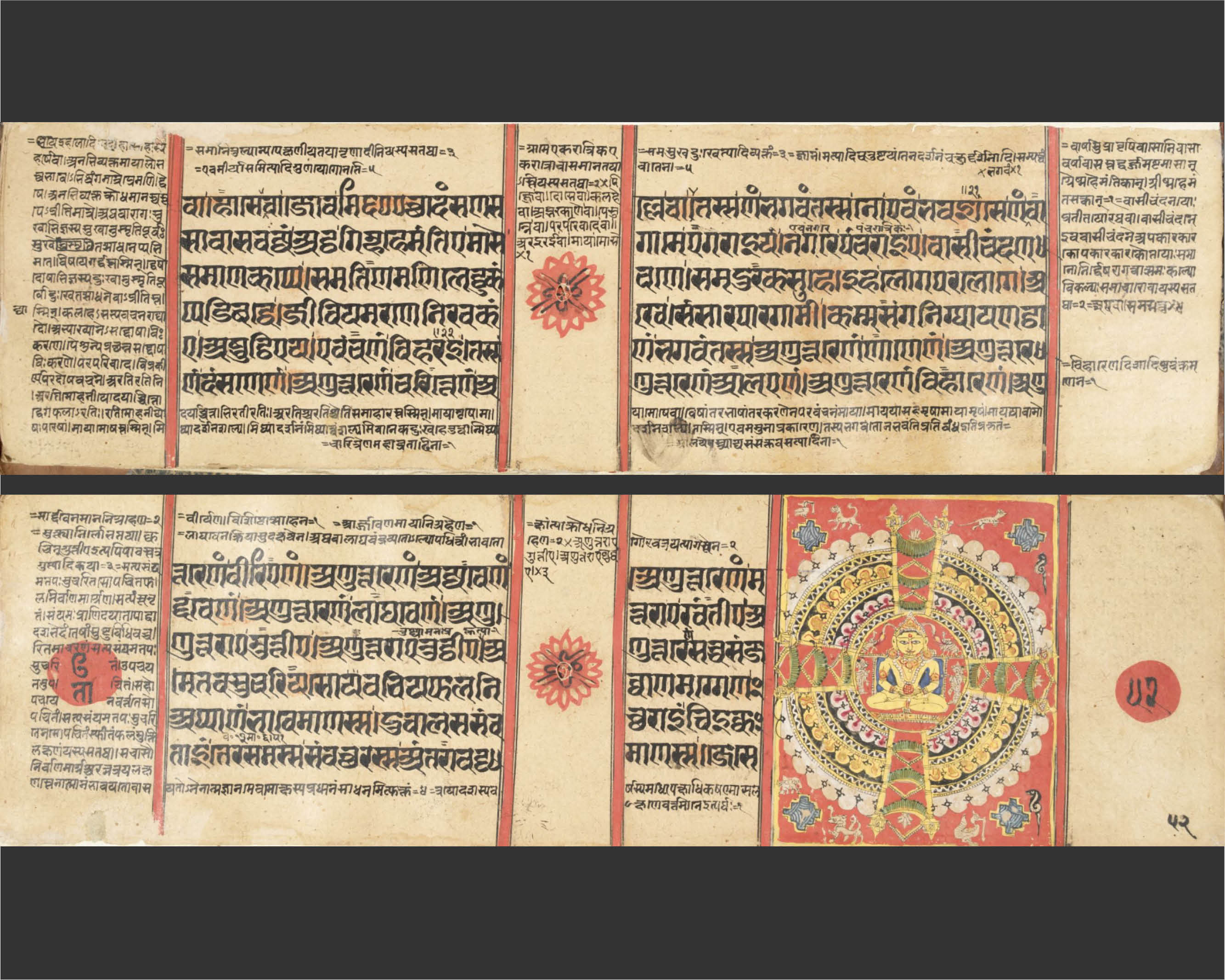
Kalpa-Sutra manuscript(Image Link: Kalpa-Sutra – Section on Mahavira.
Image Source: ©Jainpedia 2014, Image copyright: The Jain universe online at www.jainpedia.org. Creative Commons Public Domain.)02. background
Jain manuscripts are a source of inspiration for many artists, designers and calligraphers. They are known for their paintings, layouts and exquisite calligraphic styles. Paintings from these manuscripts have been extensively studied to analyse the distinct painting styles; however, the calligraphic writing has not been analysed in great detail. There are some calligraphers and designers who have studied certain aspects of Jain calligraphic styles, but these studies have by and large, been limited to personal exploration and experimentation of individual styles. In our study of Jain manuscripts we primarily focused on calligraphic analysis of the written text. This calligraphic text is compared with the contemporary Balbodha Devanagari style calligraphy for better understanding. We also considered current Jain manuscript writing practices in terms of the style which is used, tools and stationery involved, etc.
03. what are we going to study?
This is an introductory module about the design of Jain manuscripts. It is divided into two main sections. Section A focuses on understanding the layout of a Jain manuscript and the process of creating the manuscript whereas Section B is about the Jain Devanagari calligraphy style.
3.1 jain manuscripts and layout study
Section A will guide you through the process of making a Jain manuscript. It will introduce you to the surfaces, tools and inks that are used in the Jain writing tradition. Later, we will examine the layout of a Jain manuscript. It is important to look at the layout of a manuscript to get a better understanding of its calligraphy. In the Jain tradition, after the manuscript is written, it is stored using specific methods. It is fascinating to study how these manuscripts are covered, protected and preserved. Each and every step and the making of the manuscript will be explained through text and illustrations. In the end of this section, a video tutorial will teach you how to make a Jain manuscript. It will cover aspects like the choice of paper sizes, drawing the grid, the colour combinations that are to be used, etc. At the end of both the sections, there will be short exercises and quizzes to test what you’ve understood.
3.2 a calligraphic analysis of the jain devanagari style
Here, we focus on the analysis of calligraphy. This module explains the letter proportions of Jain Devanagari letters and their uniqueness, and also provides a detailed understanding of letter ductus and numeral styles. These concepts are explained primarily with visuals, which will help you to understand letterforms appropriately. The module ends with a video tutorial and a manual of calligraphy, which explains in detail how to practise the Jain Devanagari calligraphy style. Through this module, we hope students will take more interest in the Indian manuscript tradition and the skills of writing.
04. section a: introduction
The making of the Jain manuscript is an interesting process in which many tools, inks and surfaces are employed. It is important to know how these tools were prepared and used because they influenced the size of the manuscript and invariably the layouts.
So let’s get to know a little more about the surfaces, tools, inks and the process of making a Jain manuscript.
In ancient India, the oral medium of instruction was preferred over the writing tradition. Even the early Jains used the spoken word to propagate the knowledge and philosophies of their religion. The Jains understood the limitations of the oral tradition during a massive famine attack. Legend has it, that after this natural calamity, the Jains started to transcribe their teachings from the oral to a written form. In the Jain tradition, writing started only after the fourth-century CE. There are mixed opinions regarding the date of the earliest written manuscript. Although some suggest, the oldest transcribed manuscript available is not earlier than tenth century. They gradually became popular after that period.
From the eleventh century onwards, deliberate efforts were taken to restore the manuscripts in order to preserve Jain teachings. Donations for manuscript making were encouraged around this period. Gradually, the commissioning of manuscripts of sacred texts became a religious activity among Jains. These written texts were decorated with rich colours, religious symbols and paintings. They were always deposited in ‘Shashtra-Bhandaras’ and considered to be sacred objects. In these Shashtra-Bhandaras a variety of illustrated books, palm-leaf manuscripts, paper manuscripts and cloth patas (cloth paintings) are found. Thus, due to its multifaceted artwork, the Jain writing tradition is of interest to many artists, painters and calligraphers.
4.1. surfaces
The manuscript writing tradition has a long history in India. Natural mediums like palm leaves, cloth, paper, wooden-planks, stones, birch-bark, copper plates, silver plates and gold plates, etc. were used as surfaces to write upon. Earlier, the holy Jain texts were written on palm leaves. Painted wooden book covers that were made around the eleventh century have been discovered in several locations. In India, from the north to the south, palm leaves were easily available, making it a popular material for writing. Paper was introduced in India much later, until which time palm leaves were popularly used in the Jain writing tradition. According to the evidence, Jain texts were written on palm leaves until the 13th century CE but later, from the 14th century CE onwards, they had been documented on paper as a result of the availability of paper. The oldest palm-leaf Jain manuscript found in India is from 1062 CE.
In the Jain tradition, books that were written were called ‘Patli and Pothi’. There were five different types of books found in this tradition — Gandi, Kacchapi, Mushti, Samput Phalak and Chedapati.

Image 02. A palm-leaf manuscript
(Image Link: Brahaccurnivyakhya (Or. 1386) a manuscript written on Palm-leaf.
Image Source: ©Jainpedia 2014, Image copyright: The Jain universe online at www.jainpedia.org.
Creative Commons Public Domain.
Kalpa-sūtra – Section on Mahāvīra, Image Source: Jainpedia (2014)
Image copyright: http://www.jainpedia.org/ Creative Commons Public Domain.
4.1 a. palm-leaf manuscripts
A ‘Palm-leaf manuscript’ is a manuscript that is made from dried palm-leaves. In Sanskrit, a palm tree is called तालवृक्ष (Tal-tree). It is also known as ताडवृक्ष. There are two types of palm trees found in the Indian subcontinent: खरताड and श्रीताड. खरताड (Palmyra Palm) are a species of palm trees that are found near Gujarat, in the western coastal regions of India. श्रीताड (Talipot Palm) tree leaves are somewhat stiff and are thicker in nature, thus they were commonly used as a writing surface.
Palm-leaf manuscripts were created either from the long leaves of the Talipot palm or from the shorter leaves of the Palmyra palm. These leaves are of a long size, usually 20 to 50 centimetres long and from 3 to 5 centimetres wide. Palm-leaf manuscripts are typically seen in the form of bundles of 50 to 100 neatly shaped leaves of even sizes bound together with a string.
In order to prepare the leaf for the writing process, the leaves were first dried in a controlled manner. Later, they were put into boiling water and burnished well with spices like turmeric. Through this process, the surface of the palm-leaf became smooth and ready to use. These leaves were then trimmed into required sizes, and were used as a bundle of loose leaves. This bundle was subsequently covered with thick wooden planks, which were usually decorated with colourful illustrations.
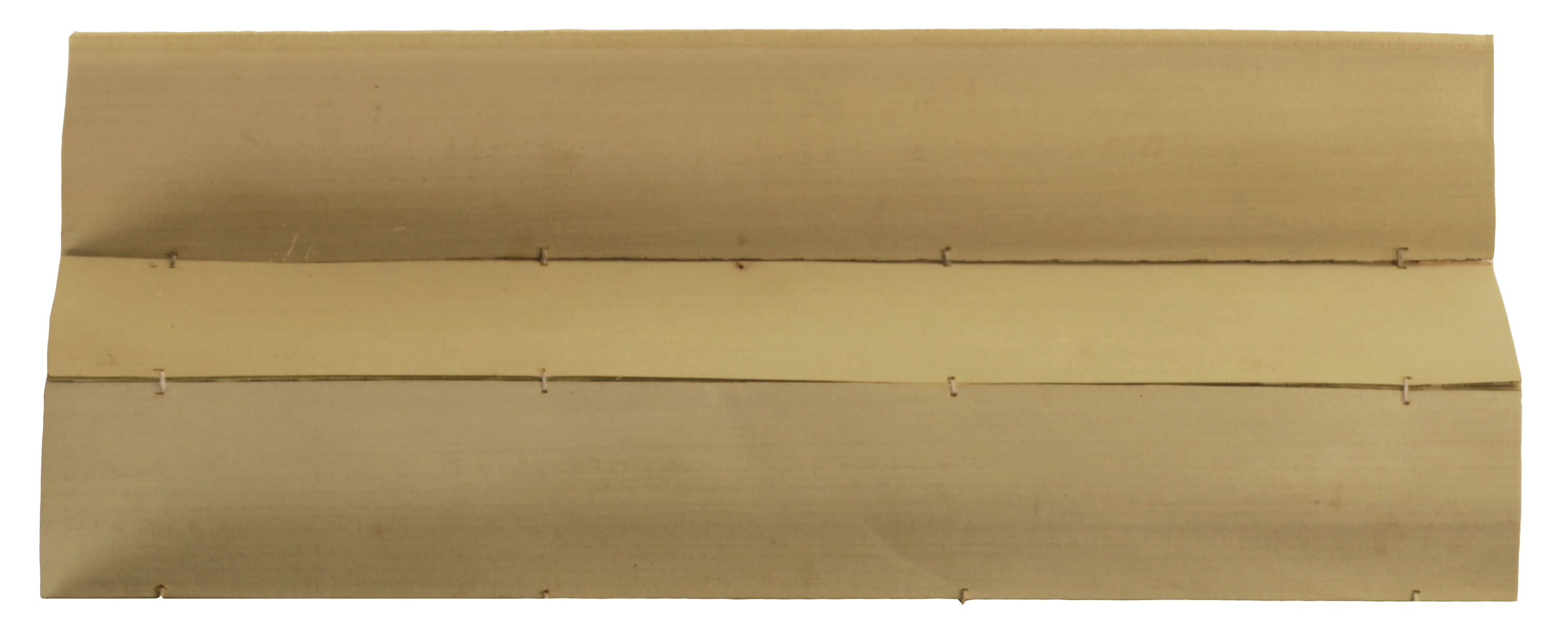
Dried Palm-leaves bound together.
4.1 b. handmade-paper manuscripts
Handmade paper was also a popular medium used for writing Jain texts. Even today it is used to write contemporary Jain manuscripts. This paper is made from natural ingredients, without the use of any machines, hence the name ‘Handmade Paper’. Such manuscripts are found all over the country.
Paper was prepared from naturally available materials like jute or bast fibres, cotton and so on. The pulp of these materials was poured onto a rectangular mesh-like tool, in order to make thin sheets of paper. No chemicals were used during the process to bleach the paper, hence the creamish-yellow look of the paper was retained. The crooked edges of the paper were trimmed before they were used for writing.
Handmade paper tends to have a rough surface because of its fibrous texture; this texture interrupts the movement of the pen strokes. Therefore, the paper was then smoothened with the घूंटो /अकिक (stone), a particular stone used for smoothing the paper's surface before writing.
Earlier paper manuscripts were long and narrow in height like palm-leaf manuscripts, later they became much broader due to the introduction of varied paper sizes (Image 06). The size of a paper manuscript was around 26 x 9–10 centimetres. Jain manuscripts that were made after the 14th century used mostly paper as a surface for writing.
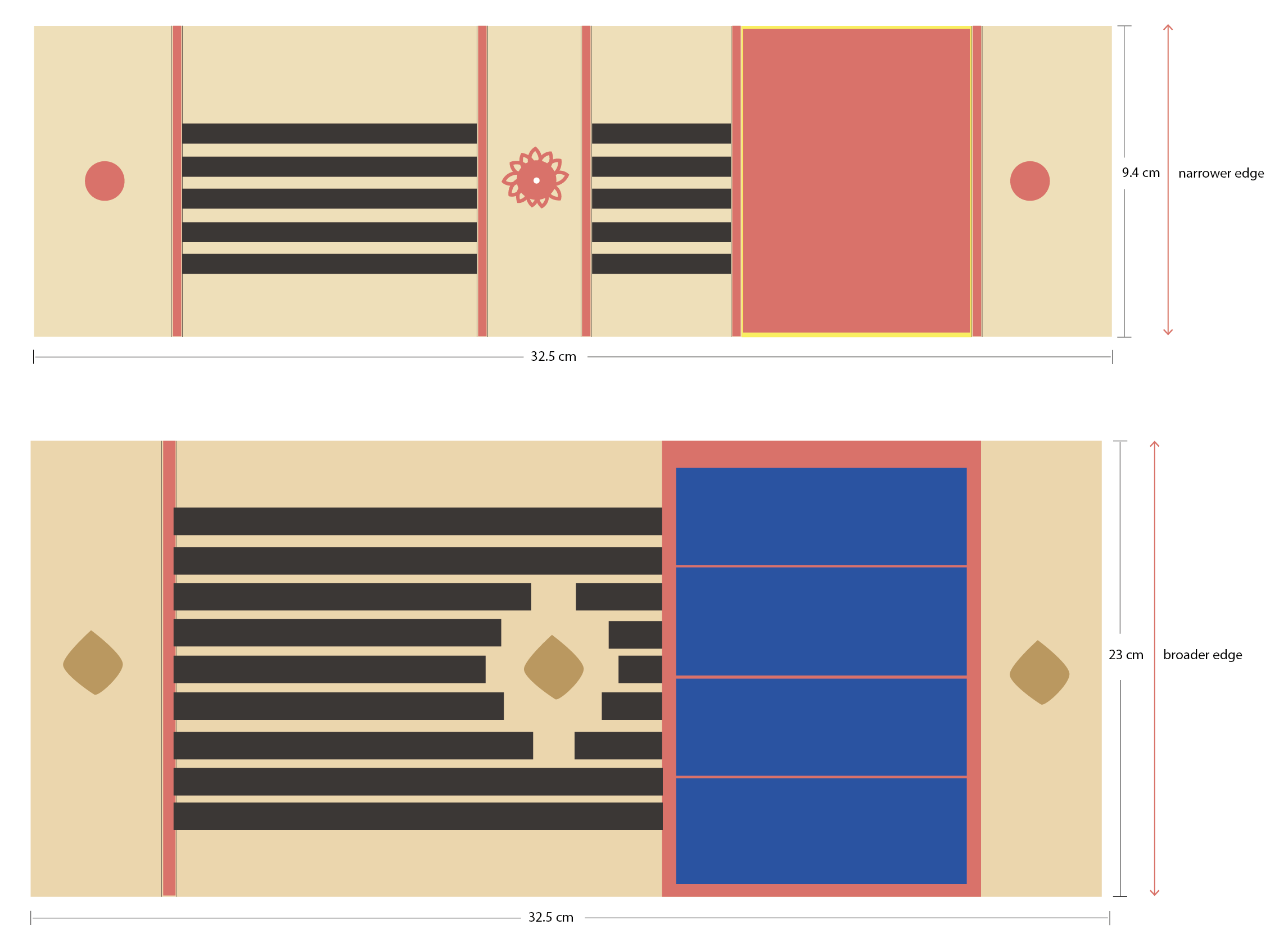
Image 06. Manuscript sizes
4.2. Tools and Stationery
Until now, you have had a brief introduction to the history of the Jain writing tradition and how manuscript writing was considered to be an act of religious merit. We have also discussed two types of writing surfaces — the palm-leaf and paper. Moving on, we will see the different types of stationery and materials used while making the layout of the Jain manuscripts. It is essential to know these materials because they are what make the Jain writing tradition exclusive through their distinctive characteristics. All the stationery which is used in making the manuscript has a distinct terminology. These manuscript writing tools are significantly different from tools that are usually used in Latin calligraphy. Hence, before we dig deeper into studying the Jain calligraphic style, we need to understand the types of tools and stationery used.
4.2 a. boru
The writing tool is called a Lekhan (/लेखण)in Gujarati. Different tools have been used to write different types of scripts in India. In southern India, a stylus was used to inscribe on the palm-leaf manuscript. In North India, a writing tool called Boru (/बो#) was and still is used for writing. Several varieties of the Boru are available; significant among these are Kala Boru ( /काळा बो#), Bas Boru ( /ब"स बो#), and Tajiya Boru ( /त"जया बो#)(Punyavijayaji, 1936).
Kala Boru and Tajiya Boru were mostly used for writing Jain manuscripts. Unlike its name, Kala Boru is actually reddish in colour. The Tajiya Boru is a ‘bulrush’ and is relatively brittle as a plant. However, its sharpened tip is resistant to abrasion and can last for a long time. This type of Boru is ideal for writing manuscripts; even present-day Jain manuscripts are written with it.
A Tajiya Boru is a reed which is cut into smaller pens of around 10–12 cm length. This unsharpened Boru is later prepared for writing by cutting its tip with a slant cut. The cut is made at an angle of about 32–40°. This cut Boru is known as the Lekhan (/लेखण).Other names of Lekhan are Vataran (/ वतरण, in Sanskrit it is called अवतरण)and Kalam (/ कलम).
In the Jain-nagari script letters have a squarish rectangular shape; these letters demand a Lekhan which is suitable for writing the rectangular shapes. There were different tip sizes required for writing small, medium and large sizes of the texts. Thus, the Lahiya used to maintain various sizes of the Lekhan. Sometimes if the cut was not precise or the ink contained too much water then this Lekhan did not write properly on the surface as the script strokes got interrupted. To avoid this inconvenience, a small slit was made to allow the ink to flow smoothly through the tip of the Lekhan. Sometimes, a thick thread was rolled up near the tip of the Lekhan to absorb the excess ink, allowing the rest to flow smoothly.
4.2 b. akeek
The Akeek/Hakeek ( / /अक#क/हक#क ) stone is an important object used in the process of making the manuscript. It is a black onyx stone—essentially a round volcanic rock that has a glassy (smooth) texture. The size of the stone is around 5–6 cm in diameter. It looks like a paperweight that is black in colour, but it is primarily used for polishing the surface of the handmade paper.
Handmade paper is made using the pulp of many fibrous materials. These ingredients make the paper’s surface rough and uneven. The original texture of the paper makes it inconvenient for writing; the Boru occasionally gets interrupted by the rough surface of the paper. Rubbing the Akeek smoothens the paper, and imparts a shine to it; which makes it more efficient for writing upon. Akeek is not only used before writing, but after the writing is completed, as well. This technique is similar to the contemporary technique of buffing the paper which adds lustre to it.
Papers which have a smooth texture do not need to go through this process. It is only handmade papers that need the polishing, before and after the writing process before and after the writing process.
4.2 c. kambi
The Kambi/Kambika ( / / क"बी / कंIबका) is used as a ruler while creating the manuscript. Kambi is a tool that is used for drawing lines on the palm leaves or paper. Basically, it is a ruler that is helpful for making guidelines on palm leaves as well as paper. It is also used for creating guidelines for the intricate border decorations of the manuscripts. The Kambi is made from a bamboo strip, and is often seen with decoratively carved ends
The length of a Kambi is approximately 12 to 14 inches. This wooden ruler has a slit on both surfaces (refer illustration). The slit prevents the edge of the Kambi from touching the paper which in turn stops the ink from spreading while the drawing lines. This was a feature so unique that it reflected on the skillful craftsmanship of the artisans from that particular period. The same Kambi tool is used even now in Jain manuscript writing. It also known as Aankani (અાંકણી /आंकणी,). The same tool is also used for drawing the geometric Mantra-Yantra illustrations of the Jain tradition.
4.2 d. oliu
The Jain manuscript text is fairly dark in texture. The calligraphic text is written along harmonious parallel lines, this particular feature of the manuscripts makes their appearance unique. It is important to understand how these parallel lines are made. The horizontal guidelines used for writing are made with a tool called Oliu (ઓળિયું/ ओळियु).
The Oliu is made from a wooden board which is approximately 21 cm x 11 cm in size. Equidistant waxed threads are fixed one-below-the other on the board. In order to use the tool and get the impression of the horizontal grid on the paper, the paper is kept on top of the Oliu and pressed against the threads on the board. This pressure creates an impression of parallel lines on the paper; these are then used as reference points while writing the text. The Lahiya uses both the sides of a paper to write the text. The Oliu creates an impression on both sides of the paper. Since both the sides are used for writing, the Oliu is used only once to create the grid on one paper. This made writing easier as Jain manuscripts were written, and still are written on loose sheets of paper.
Oliu is used for paper manuscripts and not for Palm-leaf manuscripts. In the case of palm-leaf manuscripts, lines were drawn directly onto the dried leaf which was then used for writing upon. The Kambi was used for drawing these lines on the palm-leaf surface; the Oliu cannot be used here owing to the nature and thickness of the palm leaves.
The Oliu is a unique tool in the Jain writing tradition. This grid-making tool has significantl influenced the manuscript layout, as well as the style of the script. In the coming sections, we will further discuss how the layout of the manuscript was shaped due to the Oliu.
4.3. inks
So far we have seen the various tools that are employed in Jain manuscript writing. These are objects that initiate the writing process. Another vital material required for writing the manuscripts is the inks.
The ink used is known as ‘स्याही’ (Syahee) (Persian origin), ‘शाही’(Shahee) (Hindi) or ‘મષી’ (Mashee) (Gujarati). The word ‘મષી’ (Mashee) seems to have originated from the Sanskrit word ‘मसी’ or ‘मषी’ meaning ‘black as ink’. Black, Yellow, Red, Blue, White, Gold and Silver inks were extensively used while creating an illuminated manuscript. Jain manuscripts are also famous for their natural colours. All these natural colours make the manuscript aesthetically appealing and have a long life. These natural colours were made from many other ingredients too. We will discuss here how to make these colours.
4.3 a. black
Black coloured ink is made from lamp black. It was traditionally produced by collecting soot from oil lamps. This collected soot was then mixed with sesame oil. It was used for writing text and often to draw illustrations in the manuscript. Black ink was made from relatively cheaper ingredients, hence it is seen widely in Jain manuscripts. Moreover, Black is the darkest colour available and is hence suitable for writing long continuous texts.
4.3 b. red
Similar to black, red is also quite commonly seen in the Jain manuscripts. Red ink was made with ‘Hinglok’ (‘/Iहगं ळोक). Cinabar is the scientific name of a Hinglok. It is a bright red mineral composed of mercury sulphide. A piece of Hinglok was mixed with glue and sugared water, which were then appropriately mixed together. This mixture was again diluted with clean water. After dilution, the mixture it was left in a flat plate and after a while, the excess water was removed from the mixture and the leftover residue was used as red ink.
In Jain manuscripts, the colour red is used to draw the thin side-borders and to draw the red dot for the page numbers. It was used for the Jain Mantra-Tantra paintings as well. Red was also used within the text to draw the ‘Viram/Danda³’ in sentences. The bright red colour looks attractive on the beige coloured paper which is written in black text.
4.3 c. yellow
Yellow coloured ink is mostly used for text correction in Jain manuscripts. The yellow ink was prepared from Hartal (, हरताल) which is claimed to be made from the urine of a cow. This colour is occasionally mixed with white ink and then used for correcting errors.
In the Jain tradition the texts were written first by Lahiyas, and later these manuscripts were checked by a Muni (Monk). Mistakes in the texts were then corrected with this yellow ink. It was used as a whitener on the off-whitish paper surfaces. At times yellow ink was also used in illustrations and other motifs in the manuscript.
4.3 d. gold
Gold and silver inks are prepared from a gold and silver Lamina (/वख)# . The process for making the gold and silver inks is somewhat different than that of making the other inks. To begin with, the lamina is mixed vigorously with a natural glue paste and sugar water inside a lukewarm pot. After some time when the pot becomes cold, the residue settles to the bottom, and water floats above it. The water is then carefully drained out in such a manner that the golden/silver mixture is not washed away with the excess water. This process is repeated 3–4 times, ensuring that the glue-textured gold/silver coloured paste is retained in the pot.
The process for making these inks was laborious and time consuming; added to the fact that the raw materials were very costly. This made golden/silver inks very expensive and therefore, their use was limited to border decorations, important illustrations or front page or chapter titles. The Kalpasutra manuscript was frequently illustrated with golden and silver colour inks.
These inks were sometimes used for writing the texts. The inks were used on the darkest background possible in order to achieve a higher contrast. These inks shine or glow even in low light. Thus, it was possible to read and recite manuscripts that were written with golden/silver inks, at night during the ten-day festival of Paryushana.
³ A punctuation mark for full stop
05. the process of manuscript making
In the earlier sections, we have studied the materials that have been used during the manuscript making process. The process starts with making a tool for writing. A Boru is a type of reed plant, which is cut into 6–7 inch length such that one end is left more pointed than the other. This tube shaped thin stick of reed is sharpened to create a Boru. This wellsharpened Boru is now ready to use for writing. After making the Boru, it is time to prepare the writing surface; for this we use handmade paper, which is beige in colour. We can cut the paper in the ratio of 4:1 or 3:1. The paper surface is smoothened with an Akeek stone in order to remove roughness from its surface. Nowadays handmade paper already has a smooth texture; therefore it is not required to polish it with Akeek.
A smooth paper reduces friction and resistance to the pen and gives sharpness to the writing. Once the paper is ready for writing, a thin red margin is drawn on the left and right side of the paper.
This paper is then pressed upon the Oliu to take an impression of the parallel threads. This creates a baseline grid on our paper which is subsequently used as a reference for writing. In case the Oliu is not available, parallel horizontal lines can be drawn on the paper with a pencil and ruler. Inks such as black and red are prepared and used for writing.
After completion, these handwritten manuscripts are covered with wooden boards or thick cardboards made into a front and back cover, which holds these loose bundles of pages. The entire manuscript is then wrapped in a cotton cloth scattered with small pieces of वेखंड (Calamus) which is used to protect the manuscript from fungus, insects, white ants, etc. Further, these covered bundled manuscripts are stored in teakwood cupboards to keep pests away. The following figure describes the different stages in the manuscript making process.
06. layout study
We have discussed the mediums, tools and inks that are employed during the manuscript writing process. These manuscripts were made in the Indian subcontinent a very long time ago. However, there still are many institutions which continue the process of manuscript writing. The manuscript styles have evolved over time. Each period has its unique impact on a particular style. Apart from the painting style of these manuscripts, what is interesting is their exquisite calligraphy style. Before we get into the detailed study of their style of calligraphy, it is vital to understand their layout, how their page elements are placed on it, the proportions of the pages, and so on. Through this study, we will be able to learn how the tools influence not only the layout but also the calligraphic style. In this section we have demonstrated page proportions and page elements through illustrations and graphics and therefore students are recommended to look at those graphics carefully in order to learn more about the manuscript layout.
To analyse the layout style of a Jain manuscript we have taken a sample (online resource) of the Kalpa-Sutra manuscript. The title of the manuscript piece is ‘Kalpa-Sutra section on Mahavira’. The author of this manuscript is not known. According to the sources, this piece of work was created in 1404 CE around the region of Western India. This manuscript has around 97 folios (Pages), numbered 16 to 112, while 1 to 15 are missing. The text is written in Prakrit/Sanskrit language and is written in neat Devanagari script. We will do a detailed study of the calligraphic style in Section B of this module.
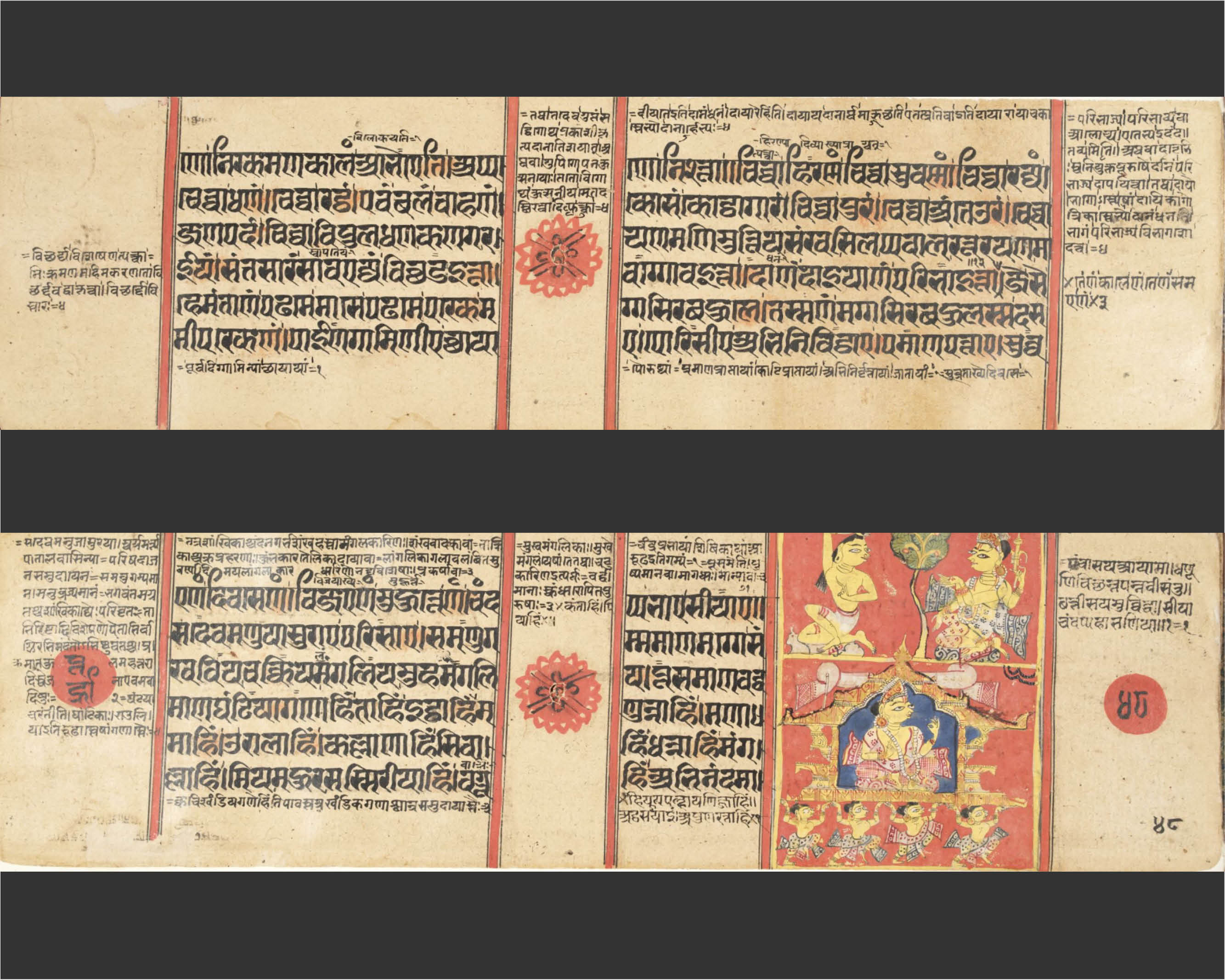
Image 16a. Kalpa-Sutra manuscript pages (Image Link: Kalpa-Sutra—Section on Mahavira, Recto and Verso page. Image Source: ©Jainpedia 2014, Image copyright: The Jain universe online at www.jainpedia.org. Creative Commons Public Domain.)
In this manuscript sample, the width of the paper is 32.5cm and the height is 9.4cm. Therefore, the proportion of the width to the height is roughly 4:1 (Image 16b). We can see here, that the text is generally arranged in two columns, and this remains consistent across all the pages. The horizontal page format influences the width of the columns and they appear rectangular in shape. The proportions of a page are also helpful while shaping the text block. Here the text block and the page proportions are the same, that is, 4:1 (Image 16b). Furthermore, we can notice that the column to the left is smaller in width than the column to the right (Image 16b). Through this analysis of page proportions, we can infer that the paper folios were inspired by palm-leaf manuscripts in many aspects, such as the folio-size ratio, the division of the folio into main two columns, margin style, etc.
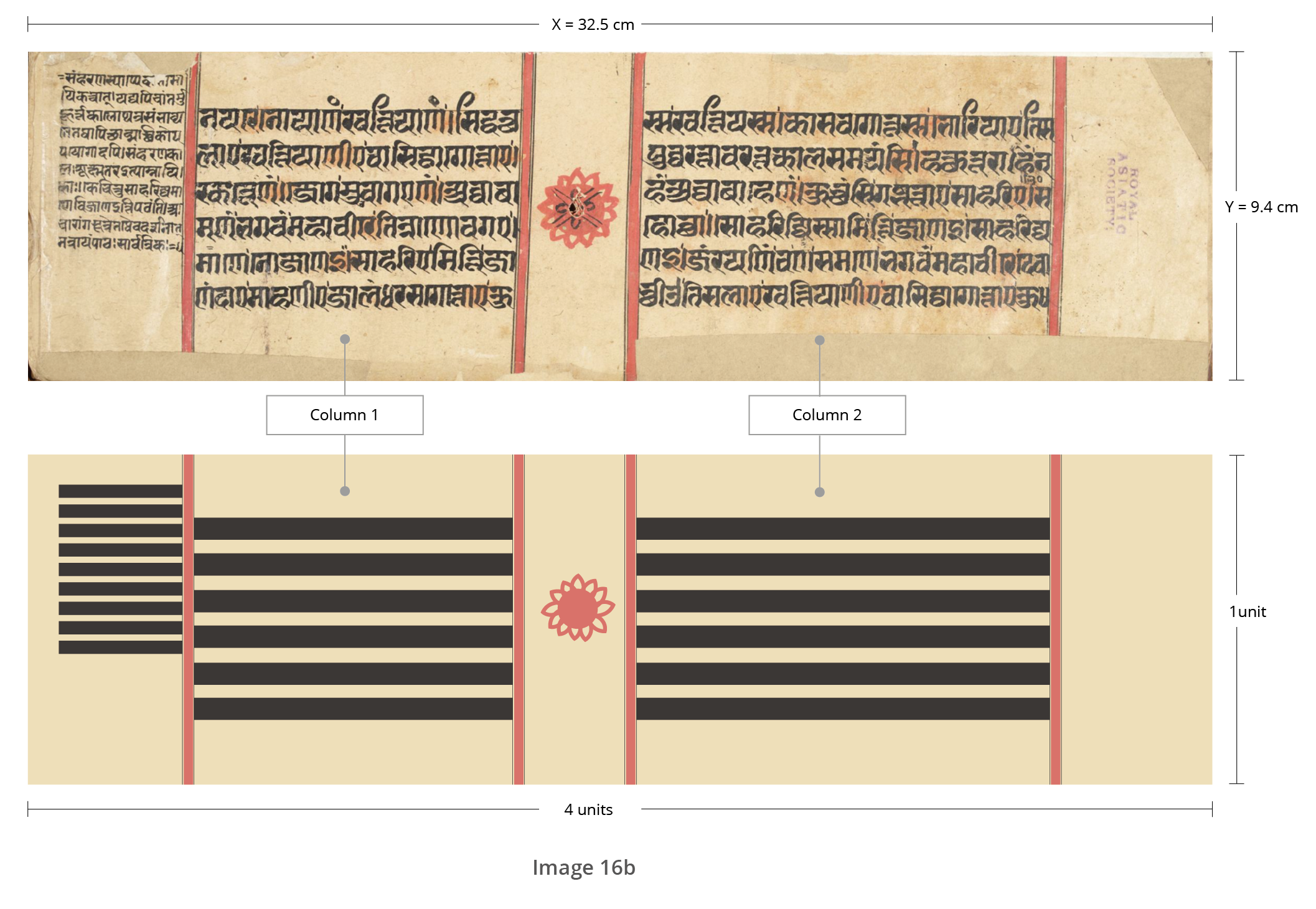
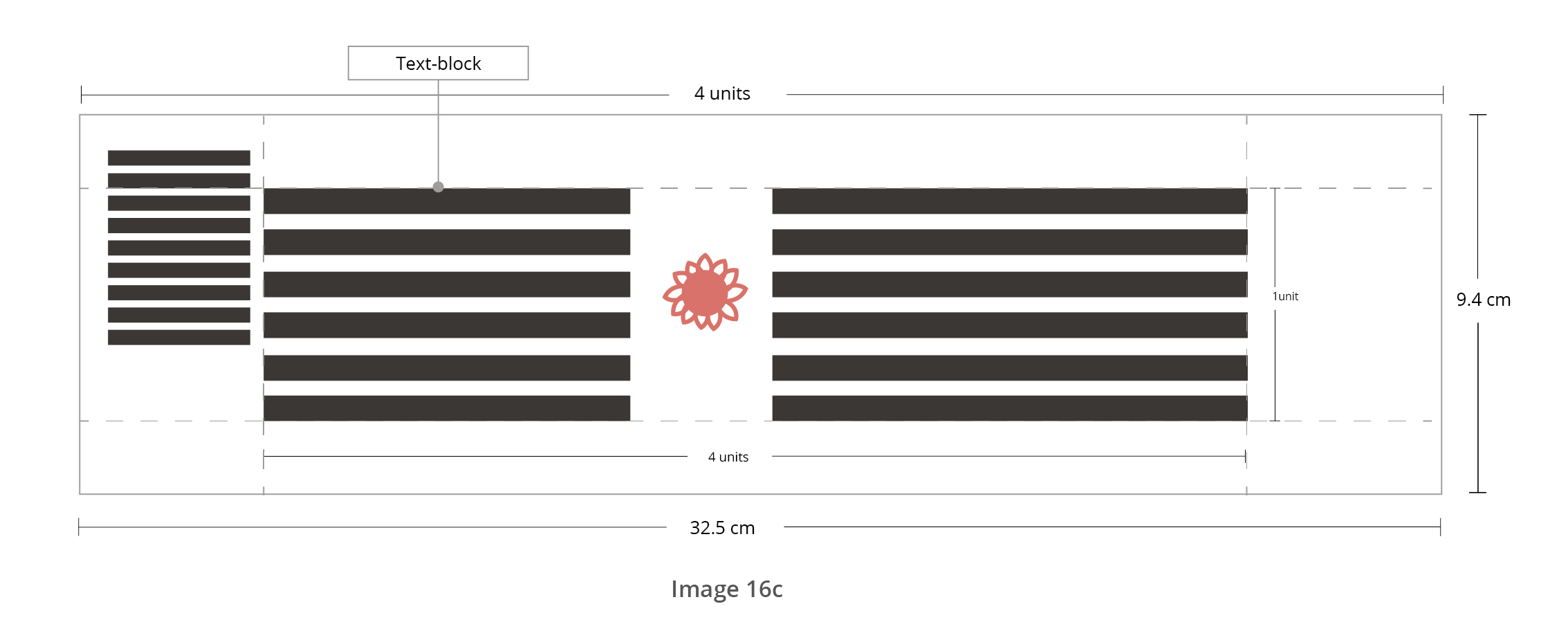
The borders define the columns within the page layout. Thin black-coloured double lines are filled with red colour, drawn to specify the columns on the folios. In the layout, the proportions of the margins are 2:1:2:1 from the right fore-edge to the upper edge to the left fore-edge to the foot edge (Image 16c). The margins on the left and the right are respectively 43mm and 42mm. The left column is 82mm wide and the right is 123mm, and both columns have a 5mm border.
We can see that the folio numbers are written within the margin space, that is laid out in the centre of the margin area on the right side. There is usually a folio number inscribed over a red circle. On the left-side margin, you can find the page number written in words.
In this particular example of a paper manuscript, the practice of making a string-hole was derived from the palm-leaf manuscript. It can be noticed here that a hole is made in the center of the page. Usually the hole is made to pass a string through all the loose folios to hold them together. It seems that in order to avoid the paper getting damaged from the thread being continuously inserted, the gutter space in the column layout has been kept as wide as the top margin.
This hole is decorated with a red circle or is occasionally decorated with auspicious decorative symbols (Image 16e).
Intricately painted illustrations are present in some folios of the manuscript. They divided the two columns into three columns. They are in the shape of a squarish panel that occupies the top and the bottom margin of a manuscript. This full height of the image-area of the illustration is what makes the folio more interesting as a whole page (Image 16e).

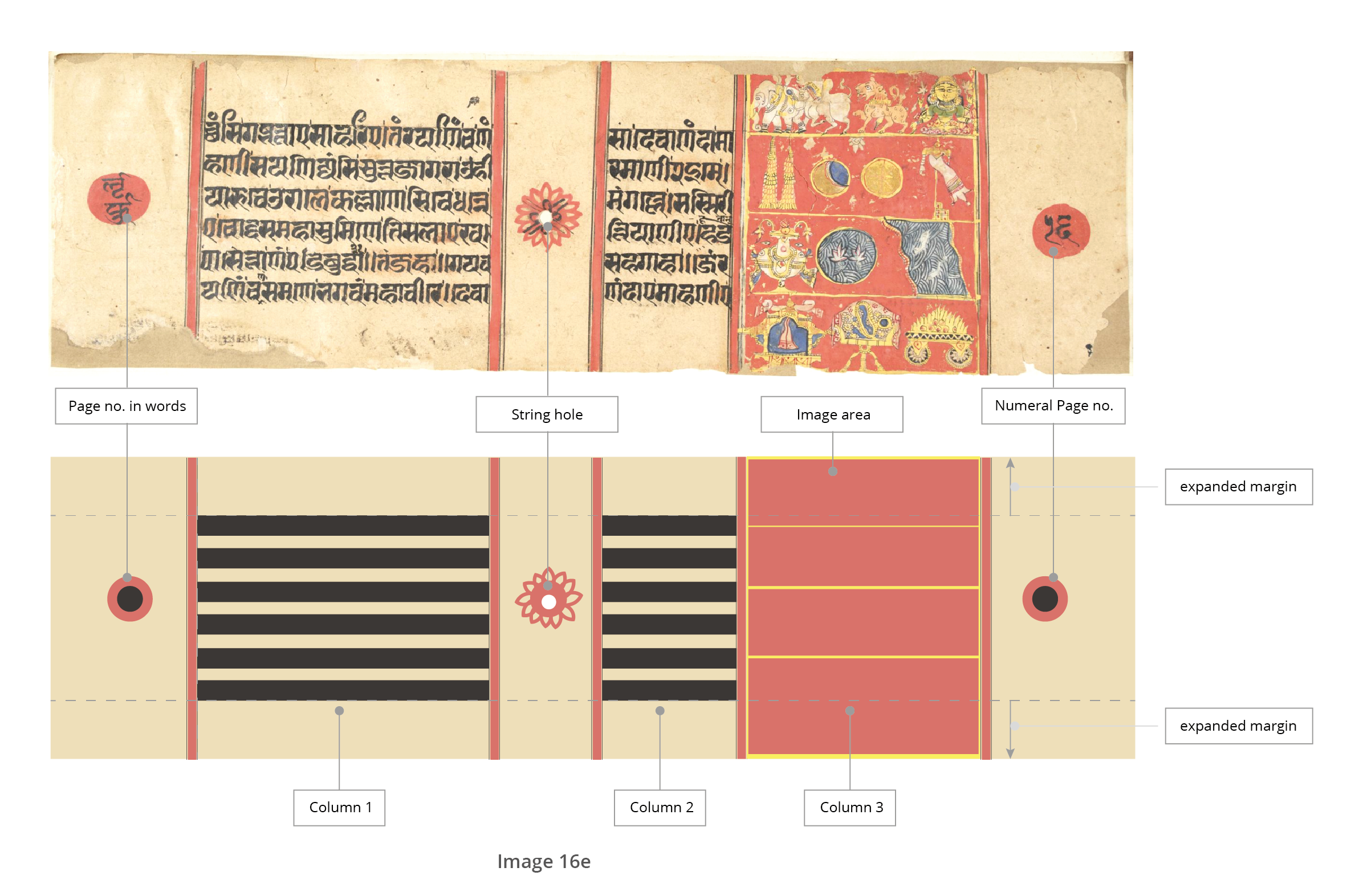
In this particular manuscript, one can see six lines per column. Here, marginal text can sometimes be seen in the wide margin area of a page layout. These notes are written in a smaller size than the main text (Image 16f). The calligraphic style of the side notes is slightly different from the main text style. This is probably to differentiate the main content of the text from the notes. The line height of the main text is around 6–7mm; the leading space is 4mm (Image 16f). The leading between two lines is relatively small. Overall the manuscript text has a dark grey texture; this dense texture is balanced well with wide margins. The composition of the text, images and calligraphy is simple and balanced to look at.

07. how to create a manuscript
In this video tutorial, we will learn how to create a layout like Jain manuscripts. This DIY (Do-It- Yourself) video will help us understand each step of the manuscript-making process briefly. It is vital to make an appropriate grid-based layout before we start writing letterforms of the Jain Devanagari style. So let us start making a beautiful manuscript.
08. the manuscript writing tradition today
The written texts from these manuscripts were in the Brahmi-Devanagari script. The styles of the letterforms are very much influenced by the Brahmi-Bangla script. We can perceive someof the visual features of the Bangla script in Jain Devanagari letterforms.
We have discussed about the tool which has been used in the Jain writing tradition. In the Jain manuscripts, the letters are drawn with different types of Boru. These letterforms look more rectangular in their shape. All these letterforms seem to have a vertical rhythm in the text with very little word space in between. We will discuss the structure of these letterforms in further detail, in the Jain manuscript analysis (Section B). The contemporary style of Devanagari calligraphy is relatively different compared to the Jain manuscript calligraphy style from the 14–15th century. The Balbodh style of calligraphy is quite popularly used in modern times.
The Devanagari letterforms in this style have a round curvature, and larger उ-kar matras. The widths of the individual letterforms are wider than the earlier Jain Devanagari calligraphy style.
Therefore, it is quite interesting to study Jain manuscript writings from two different periods. One is an old style while the other is more contemporary in nature.
09. sources of jain manuscripts
There are many places where one can visit and see, or even refer to these manuscripts. Sometimes, with permission from the respective organizations, it is possible to go and study the original copy of the manuscript. Here is a list of some institutes, museums and private repositories from where one could access these manuscripts.
Museums
- Chhatrapati Shivaji Maharaj Vastu Sangrahalaya.Fort, Mumbai, Maharashtra, India.http://www.csmvs.in/
- Lalbhai Dalpatbhai MuseumNavarangpura, Ahmedabad, Gujarat.http://www.ldmuseum.co.in/
- The Bhandarkar Oriental Research InstitutePune, Maharashtra, Indiahttp://www.bori.ac.in/default.html
- Asiatic Society,Mumbai, Maharashtra, India.
- Thanjavur Maharaja Sarfoji Saraswati Mahal Library,Thanjavur, Karnataka, India.
- The Victoria and Albert MuseumLondon, UK.
Jain Bhandaras (Jain Repository)
- Jain Shrut Mandir Princess Street, Crawford Market, Mumbai.
- Many Jain manuscript repositories found in Patan in Gujarat state of India also Jaisalmer, Jodhpur in Rajasthan.
Further Links
- Jainpedia http://www.jainpedia.org/home.html
- The National Mission for Manuscripts http://www.namami.org/
10. coursework
10.1 Objective Questions: 0/0
Exercise 1
- Find the differences between inscription and manuscript, by searching through the Web, libraries and books.
- List out the different types of manuscripts available in India.
Exercise 2
- In this assignment we will learn to create the layout of a Jain manuscript. The objective of this exercise is to understand the layout system which was used in these manuscripts, in order to apply those layout styles in our design.
Exercise 3
- Create a layout/a replica of the manuscript on paper.
- Try and see how grids/columns will look in portrait orientation. Use A-4 sheet paper to make a manuscript layout in portrait as well as in landscape orientation.
- Compare the two layouts, to understand the advantages and disadvantages of using the manuscript grid in portrait orientation.
- Try and use the grid which we have studied in Jain manuscripts for Book Design and Page layout.
Exercise 4
- Visit the nearest museum in your town or state where you will be able to see different manuscripts. Also try to know more about the manuscript like its origin, language and script used, type of surface and tools that must have been used.
11. readings and references:
- Doshi Sarayu. (1995) The Tradition Of Manuscript Illustration, Marg Magzine, Marg Publication.
- Goswamy, B. N. (2006)The word is sacred, sacred is the word, Niyogi Books, New Delhi.
- Jainpedia, (2014) http://www.jainpedia.org/manuscripts/detailviewmeta/manuscript/kalpa-sutra-and-kalakacarya-katha-todms-34/ras-todms34-005/index.html.
- Joshi, R. (1983)Calligraphic study of Manuscript, CALTIS, Pune.
- Munishri Punyavijayji, (1936). Bhartiya Jain Shramansanskriti AneLekhankala, Sarabhai, Manilal Nawab, Ahmedabad.
- Namami, (2014). Newsletters, http://www.namami.org/downloads.html.
- Pal, P. (1994) Peaceful Liberators: Jain Art from India 1st Ed., Thames & Hudson Ltd, London.
- Dr. Chandra Moti, Dr. Shah Umakant. (n. d.), New Documents of Jaina Painting, Shri Mahavir Jaina Vidyalaya Publication.
12. Credits
| Guided By : | Prof. Girish Dalvi |
| Co-ordinator Dsource: | Prof. Ravi Poovaiah |
| Concept and content : | Girish Dalvi and Pradnya Naik |
| Layout and Images : | Pradnya Naik |
| Photographs : | Sharvari Rane |
| Infographics : | Pradnya Naik, Pallavi Shedge and Aasawari Kulkarni |
| Video Script : | Kanchan Gokhale, Yashada Kanekar and Pradnya Naik |
| Front-end Coding : | Neelank Sachan |
| Framework: | Reveal.js, The HTML Presentation Framework, Created by Hakim El Hattab / @hakime |
| Fonts Used: | Latin Font – Ek Mukta, Designed by Girish Dalvi, Yashodeep Gholap, Latin Font – Merriweather Designed by Eben Sorkin, Devanagari Font – Laila Designed by Indian Type Foundry |
| Special Thanks: | Mahendrabhai Sanghani and Dinesh Patil and the Lahiyas from Shrut Mandir for providing information on the Jain manuscript writing tradition. Saurabha Singanapalli, Dhwani Shah, Ruchi Shah, Aadarsh Rajan and Aasawari Kulkarni for their feedback on content. Also Nirav Malsattar for providing translations on Gujarati texts. |